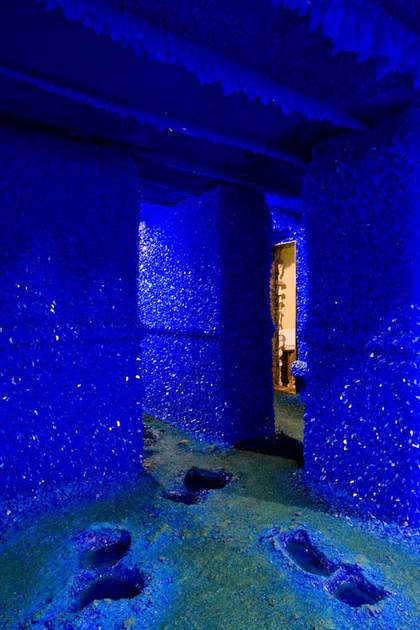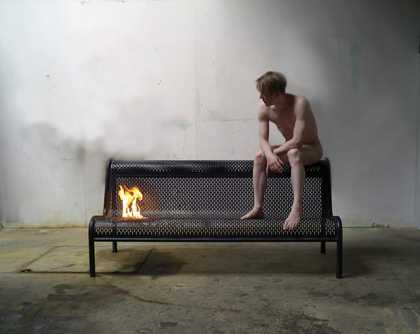Roger Hiorns makes works of art whose particular aesthetic lies somewhere between the representational and non-representational, and so disrupts our expectations of the boundaries between them. His sculptures have a seemingly straightforward, functional material presence, but this is always combined with an element which provides a sense of the imaginary, the poetic or the esoteric. The tension between these two aspects is a vital part of Hiorns’ work.
For Vauxhall 2003 Hiorns has sunk a gully into the surface of the Sculpture Court at Tate Britain but, instead of water running down through the grating, a flame rises up from it. Gullies and gutters are usually un-noticed, part of the everyday that we encounter without needing to negotiate or consider. They have associations with particular environments. In their normal context they have a specific function which is here subverted by the artist; as he explains ‘the fire transforms the reason for the gully to exist’. Transformation is a theme throughout Hiorns’ work. He has arrived at a formula which involves combining two basic elements, having found a third or more to be ‘superfluous’. The fact that he limits himself to this structure means that we are more conscious of the relationship or dialogue between the two. They transform and disrupt each other and are often materially very different: steel and perfume (used in another work also titled Vauxhall 2003), steel and thistles (Intelligence and Sacrifice 2003) or, here, a steel grating and a flame. In each case one is entirely functional and the other something that carries with it the notion of the sacred. Furthermore, Hiorns often uses a material that transforms itself, such as copper sulphate which changes from a liquid to vivid blue crystals, or soapy liquids that bubble into foam. This element allows the sculpture to finish or conclude itself beyond the control of the artist. It also introduces chance or chaos into works which are often very formal, deliberate and resolved structures.
If Hiorns’ objects look functional yet also like votive objects, they also appear familiar but totally alien, sitting in his constructed space between the representational and non-representational. The ceramic material and the forms of the vessels in works such as Two Forms (Orange and Brown) 1999 remind us of things that we come across everyday, but they are entirely unlike anything else that we have actually seen. The column of foaming bubbles that they quietly and gently emit gives them a purpose but also reinforces our sense of their strangeness. They look as though they have a function yet at the same time are not actually for anyone’s use, and we cannot fit them into our ordered world of objects that have a place and a purpose.
The artist describes Vauxhall as ‘pro-active’, working both with and against its environment. The gully grating sits naturally with the architecture and landscape of the Sculpture Court. It could almost have always been there alongside the manholes and other functional structures, except perhaps for the fact that it sits incongruously in the centre, where a drain would never actually be placed, and at a very slightly unexpected angle, at odds with the right angles that dictate the placing of everything else. At the same time the work completely alters its surroundings. The flame disrupts a safe and ordered institutional space and seems completely unconnected with it. The fire feels unpredictable and dangerous, in total contrast to the seemingly highly ordered nature of the place in which it sits.Both fire and the gutter are highly symbolic and suggestive. They allude to religion, sacred ritual and the eternal flame and conversely to dirt, ignominy, undercurrents and things hidden. As with Hiorns’ other works, Vauxhall is potentially loaded with references whilst managing to remain elusive and un-explainable. The artist sees it as a ‘proposition’ open to different and personal interpretations. His role is to place the elements in a different context which provokes these readings. At the same time it does not depend on any such associations. The work has an internal logic and reason for being that is peculiar to itself. Both this logic and the object itself exist independently of anything else. The artist says that: ‘The works are successful if they are self-contained and need nothing else. They exist by their own language.’ It is this self-containment that is common to all Hiorns’ works, however visually diverse they appear to be.
Alongside his individual, self-contained sculptural pieces, Hiorns has invented an imaginary environment or area that would provide a home for his work. This was initially conceived of as HSA – Home Space Available – a proposed social project, perhaps something like a hostelry. The artist wanted this to be a sanitised, hygienic space with suggestions of the utopian, somewhere that would be free from distraction apart from the objects in it. This later evolved into something less specific, not necessarily a building, but possibly a space or even just a suggestion of a certain area. He describes all of his works as containing their own clues about how this place might perform. One possible location is Vauxhall, from where this work and two other works get their title. Hiorns is interested in places that might share a particular aesthetic, places like Vauxhall that one passes through to get to somewhere else. Although the self-containment of Hiorns’ works is undeniable, he is also concerned that there is an intangible area between them which is inconclusive, a place that he feels needs to be ‘dealt with’, often by making another work to fill the gap between existing pieces. His projected physical space may never materialise, and in fact it may not need o exist, but Hiorns is concerned to provide a framework for the works, which allows them to relate only to each other, and not to anything else.
Text by Carolyn Kerr
Biography
Born in Birmingham, 1975
1991-3 Bournevill College of Art, Birmingham
2003-6 Goldsmiths College, London
Lives and works in London
Programme
The 2003 exhibition programme is supported by the Patrons of New Art.


